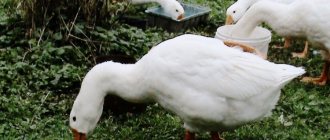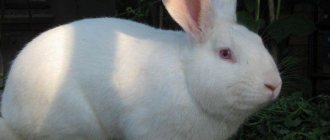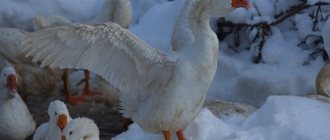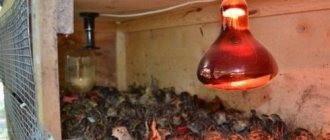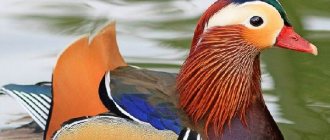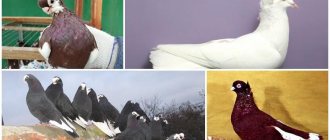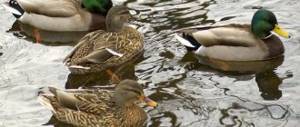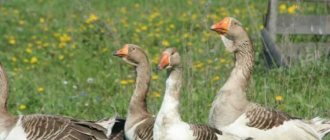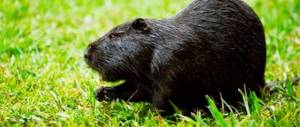Geese Raising Basics for Beginners
It is not difficult for day-old goslings to create suitable conditions; the main thing they need is a warm and dry room without drafts.
Crowded planting of young animals is unacceptable, as this leads to increased humidity, contamination of feed and water, the development of infectious and fungal diseases, inflammation of the joints, general weakness and loss of growth rates.
The minimum area for keeping small goslings is 8-10 heads per 1 sq. m. floor, for very large breeds a larger area is needed, they are planted more spaciously - 4-6 individuals per 1 sq. m. m.
Before the young animals move in, the room is prepared - cleaned after growing the previous batch, the walls are whitened with a strong lime solution, the floor is sprinkled with fluff lime, and then a bedding of fresh straw or wood shavings is laid.
In order not to unnecessarily disturb the goslings, at first the bedding is replaced only partially - at the drinkers, and the contaminated areas are sprinkled with a fresh layer of straw.
It is convenient to use an infrared lamp for poultry as a heater, which is suspended above the floor, the temperature is fixed at the level where the bird is located and the lamp is raised or lowered to achieve the desired values.
These lamps are available in a variety of types and power levels at specialty farm and pet stores. When used correctly, they are durable, practical and will last for several seasons.
Infrared lamp for poultry
Many poultry farmers make do with ordinary heating pads or bottles of hot water, wrapping them in fabric and placing them in a box with a fabric canopy; the chicks can hide and warm themselves under such an artificial hen.
For good growth and healthy development, it is very important to warm up and under no circumstances expose goslings to cold in the first week of their life.
When growing under a hen, make sure that the room temperature in the first ten days does not fall below 22 °C.
In the first days after acquiring day-old geese, the light is kept on for a full day so that they can eat and drink to their heart's content and become sufficiently strong.
The reduction in daylight hours is carried out gradually, bringing its duration to 14-16 hours by the age of one month. If the bird is kept for fattening purposes, as well as for non-productive breeding stock, during the period of autumn and early winter the day length should be 12-14 hours.
For goslings under 10 days of age, install standard automatic drinkers on a jar with a wide recess so that the beak fits into the groove and the gosling can drink normally.
To maintain dryness, from the third day the drinker is placed on a metal baking sheet with sides, on which a grate is placed on top.
For older young animals, any containers are used as drinking bowls at home, replacing the water once or twice a day. During the same period, in warm, windless weather, it is advisable to release the young animals into the enclosure, installing drinking bowls and feeders on the street, which will facilitate care, eliminate dampness and make the living conditions optimal.
To feed day-old goslings, trays with low sides up to 2.5 cm high are placed, and from the third day they are replaced with trough feeders.
From the age of one month, food is poured into feeders for adult geese, calculating their length so that the bird does not crowd, but can calmly take its place at the feeder, with the approximate length being 15 cm per head. If not all goslings are able to feed normally, sooner or later several underfed chicks will begin to weaken.
Typical feeder for keeping geese at home
A handle bar is attached along the wooden feeder, with which it can be carried, and on the other hand, the bar will prevent compaction and contamination of the feed.
Below are suggested microclimate indicators for keeping young animals at home.
Requirements for the conditions of keeping young animals
Adult geese are undemanding to temperature indicators and, with normal general condition, good fat layer and developed plumage, can be kept at sub-zero temperatures in winter. Moreover, in cool autumn and early winter weather, they gain weight well and form round, clean carcasses without stumps.
and raising geese at home
Geese are an unpretentious, productive bird, the raising of which is a profitable and exciting activity that does not require huge costs and investments, the construction of special complex premises and the creation of a special microclimate for their maintenance.
This strong bird is able to stay outside all year, using sheds or a small shed in bad weather, or for laying eggs.
Feeding geese is inexpensive and compound feed is needed only at the initial stage of rearing. When fattening poultry for meat and maintaining breeding stock, you can get by with available grain feed and any grass, including weeds.
Geese make excellent use of pastures and the water surface of reservoirs, spending the whole day walking and effectively processing pasture. They grow quickly and gain weight. With intensive fattening, the bird increases its live weight in relation to its initial weight by 30-40 times in three months, reaching a weight of 4-4.5 kg during this period.
But even extensive fattening - on grass and a small amount of grain feed - in six months will produce heavy birds weighing up to 5-6 kg or more, depending on the breed and gender.
Keeping geese for meat longer than six months is unprofitable. The bird enters the breeding season, loses weight and the meat becomes tougher. The deadline for slaughtering geese of spring or early summer incubation is December of the current or January of the next year. The optimal time for finishing fattening is October-November.
Geese Raising Basics for Beginners
It is not difficult for day-old goslings to create suitable conditions; the main thing they need is a warm and dry room without drafts.
Crowded planting of young animals is unacceptable, as this leads to increased humidity, contamination of feed and water, the development of infectious and fungal diseases, inflammation of the joints, general weakness and loss of growth rates.
The minimum area for keeping small goslings is 8-10 heads per 1 sq. m. floor, for very large breeds a larger area is needed, they are planted more spaciously - 4-6 individuals per 1 sq. m. m.
Before the young animals move in, the room is prepared - cleaned after growing the previous batch, the walls are whitened with a strong lime solution, the floor is sprinkled with fluff lime, and then a bedding of fresh straw or wood shavings is laid.
In order not to unnecessarily disturb the goslings, at first the bedding is replaced only partially - at the drinkers, and the contaminated areas are sprinkled with a fresh layer of straw.
It is convenient to use an infrared lamp for poultry as a heater, which is suspended above the floor, the temperature is fixed at the level where the bird is located and the lamp is raised or lowered to achieve the desired values.
These lamps are available in a variety of types and power levels at specialty farm and pet stores. When used correctly, they are durable, practical and will last for several seasons.
Infrared lamp for poultry
Many poultry farmers make do with ordinary heating pads or bottles of hot water, wrapping them in fabric and placing them in a box with a fabric canopy; the chicks can hide and warm themselves under such an artificial hen.
For good growth and healthy development, it is very important to warm up and under no circumstances expose goslings to cold in the first week of their life.
When growing under a hen, make sure that the room temperature in the first ten days does not fall below 22 °C.
In the first days after acquiring day-old geese, the light is kept on for a full day so that they can eat and drink to their heart's content and become sufficiently strong.
The reduction in daylight hours is carried out gradually, bringing its duration to 14-16 hours by the age of one month. If the bird is kept for fattening purposes, as well as for non-productive breeding stock, during the period of autumn and early winter the day length should be 12-14 hours.
For goslings under 10 days of age, install standard automatic drinkers on a jar with a wide recess so that the beak fits into the groove and the gosling can drink normally.
To maintain dryness, from the third day the drinker is placed on a metal baking sheet with sides, on which a grate is placed on top.
For older young animals, any containers are used as drinking bowls at home, replacing the water once or twice a day. During the same period, in warm, windless weather, it is advisable to release the young animals into the enclosure, installing drinking bowls and feeders on the street, which will facilitate care, eliminate dampness and make the living conditions optimal.
To feed day-old goslings, trays with low sides up to 2.5 cm high are placed, and from the third day they are replaced with trough feeders.
From the age of one month, food is poured into feeders for adult geese, calculating their length so that the bird does not crowd, but can calmly take its place at the feeder, with the approximate length being 15 cm per head. If not all goslings are able to feed normally, sooner or later several underfed chicks will begin to weaken.
Typical feeder for keeping geese at home
A handle bar is attached along the wooden feeder, with which it can be carried, and on the other hand, the bar will prevent compaction and contamination of the feed.
Below are suggested microclimate indicators for keeping young animals at home.
Requirements for the conditions of keeping young animals
Adult geese are undemanding to temperature indicators and, with normal general condition, good fat layer and developed plumage, can be kept at sub-zero temperatures in winter. Moreover, in cool autumn and early winter weather, they gain weight well and form round, clean carcasses without stumps.
Features of keeping adults
For comfortable keeping of adult individuals, any room can be adapted - a small barn or poultry house, built from available material. The only conditions are the absence of drafts and strong solid walls. Geese are curious, active and, whenever possible, will pluck out mineral wool or dismantle walls cast from slag, quickly finding a weak spot.
In household conditions, adult birds are housed at a density of no more than 2 birds per 1 square meter. m. Very large breeds, for example, the magnificent Toulouse geese, require even more space; they are placed no denser than one individual per 2 square meters. m.
Toulouse geese - a large meat breed
In winter, for breeding stock, a layer of not too long straw is laid in the room, making sure that the litter always remains loose, for which it is fluffed up from time to time and moistened, knocked down areas near the drinking bowls are removed.
Geese drink a lot of water - up to 1 liter per day in cool weather. In hot weather, water consumption increases sharply and can reach 2-3 liters. They are exceptionally clean birds and even in limited conditions they will never miss an opportunity to swim.
In a closed range, a small pond is set up for them to swim in, made from a trough dug into the ground or a special ditch lined with strong plastic film.
Lightweight, portable plastic swimming pools that can be easily filled, drained and washed when necessary are becoming increasingly popular. To lift the bird into a high mini-reservoir, a wide, stable ladder with transverse slats is attached to it.
In the period before the start of egg laying, wooden nests are installed directly on the floor of the poultry house at the rate of one nest for 3-4 geese. The optimal dimensions of the boxes are height 65 cm, width 50 cm, depth 60-65 cm. Straw or large shavings of non-coniferous trees are placed inside. To stimulate laying, egg linings made of alabaster or wood are used in nests.
Since the end of January, indoor lighting has been maintained at 16 hours a day, providing a balanced, high-protein diet.
In a household, it is advisable to keep geese on a walk, which will create optimal conditions for balanced development, allow the bird to move freely and work up an appetite.
Portable poultry house for geese on the run
The presence of grazing or a pond can significantly save grain feed - geese are excellent foragers and digest coarse fiber very well. For installation on the range, light temporary portable poultry houses made of wooden panels are used; if possible, they are installed in the shade of trees.
geese at home - the experience of a poultry farmer
Dear readers, write your review about keeping and raising geese. Remember that you can send a full story about the peculiarities of keeping poultry at home using our contact form. If you are a breeder and sell young stock or eggs, you can include this information, but do not forget to indicate your region of residence and contact information.
Source: https://svoya-ptica.com/gusy/soderzhanie-gusej
Reproduction and breeding of geese at home for beginners
Experienced farmers breed poultry. Beginning poultry farmers raise goslings in the summer, but if desired, they can also raise broodstock all year round. For the purpose of breeding offspring, the best representatives of the breed are selected. For every 3 females in the herd, no more than one goose is left.
Reproduction requires winter maintenance - geese begin to lay eggs in winter, about a month after additional lighting is turned on in the house. Eggs must be removed from the nests every morning while they are still warm, and stored for no more than 10 days before being laid for incubation.
Natural hatching
In April, when the first green grass appears, the geese begin to hatch their eggs. The room for brood hens should be dry and clean, free of foreign odors, with an air temperature of at least +12 °C.
Eggs cannot be moved from the nest; the bird will refuse to sit on them, and the embryos will die. You can place good eggs under the female, removing those that have a defect. Their total number should not exceed 13 pieces.
During the hatching process, the goose should not be disturbed; it can behave aggressively. To moisten the eggs with moisture, the bird must have free access to a body of water. The hen is given grain waste, dry feed mixtures, and cottage cheese as food. There should always be clean drinking water nearby.
The first goslings appear on the 27th day of incubation. When they are dry, they are moved to a dry box.
Application of incubator
If geese refuse to hatch their offspring, an incubator will be of great help in breeding goslings. It allows you to create optimal conditions for hatching chicks. Temperature and humidity during incubation should be maintained automatically.
There are certain requirements for hatching eggs:
- the shell is clean and smooth, without growths or punctures;
- the shape of the eggs is oval-round, elongated and round specimens are rejected;
- weight is approximately the same - 135 g for medium breeds and 185 g for large breeds;
- When checking with an ovoscope, 1 yolk and no dark spots are required.
Eggs intended for laying in the incubator are not washed during storage.
Features of winter and summer care
There are two main periods of maintenance: summer and winter. In summer it is easier to raise goslings, there is a lot of green food, after 2 months they are ready to be slaughtered for meat.
For winter maintenance, a frost-proof shed with straw on the floor is equipped. Nests, feeders and drinking bowls are placed inside.
Keeping geese in winter
Geese tolerate temperature drops down to -10 °C well. They have warm down that reliably protects from the cold. However, eggs freeze quickly in the cold.
For the winter, it is advisable to equip birds with a dry, draft-free room with artificial lighting. The lights turn on in winter at 6 o'clock in the morning and turn off at eight o'clock in the evening. They build nests where it will be convenient for females to lay eggs.
Containers for feed and water are placed in the goose barn. A bedding is laid on the floor. Drinkers are placed on mesh trays. When it gets colder, the birds are given more high-calorie food. If there is no snow or severe frost, they are released into the pasture to pick up the remaining grass.
Keeping geese in summer
Feeding a goose population in summer is much easier than in winter. The bird can be kept outside for most of the day, until frost begins. Thanks to this, feed is consumed 2 times less.
Be sure to read:
Is it possible to eat goose eggs, how do they differ, how to use them, should they be given to children?
It is important to know what kind of vegetation the bird likes:
- alfalfa;
- legumes;
- leaves and flowers of clover, dandelion;
- young nettle and sorrel;
- cereals before flowering.
Geese may abandon grass altogether if they try sedge, mantle or goosefoot. After returning from pasture, the geese are fed combined or wet food and grain.
Geese nests
To make nests, use plywood boxes or wicker baskets. They are placed in the back of the house, where there is no draft or bright light.
The dimensions of the nest should be 50x65 cm, height 60-65 cm, threshold - 10 cm. The inside of the nests is covered with the same bedding that lies on the floor of the goose barn, and it is changed in the evening. Gooses lay eggs in the morning.
Incubation of goose eggs
Before placing in the incubator, goose eggs are washed in a weak solution of potassium permanganate. Place them in trays and turn on the required mode.
The first 5 days maintain a temperature of +38 °C and a humidity of 70%. This humidity is left until the 14th day, then reduced to 60%. From the 6th to the 28th day the temperature should be 37-38 °C. From the 28th day, reduce the temperature to 37 °C and increase the humidity to 85%.
On the 6th day, the eggs are checked with an ovoscope and the unfertilized ones are removed. Automatic tray rotations are turned on from the 2nd day of incubation and turned off on the 28th day. Airing and spraying eggs 2 times a day begins on the 14th day.
Benefits of Goose Breeding
Goose meat has many admirers. The famous goose with apples will leave few people indifferent, and goose liver pate (foie gras) is considered a delicacy.
- Geese are also worth breeding because of the following advantages:
- unpretentiousness to feed and living conditions;
- rapid weight gain;
- precocity;
- saving feed during grazing;
- disease resistance;
- quick payback - during the summer season you can raise a lot of geese weighing up to 6 kg with minimal feed costs.
In addition to meat and liver, other related products come from geese. Goose fat is used in cosmetics and medicine. Goose feathers have long been used for writing, and now they are used to produce souvenirs and shuttlecocks for badminton. Goose down is used for sewing pillows and down jackets.
The benefits of raising geese
Firstly, you will provide yourself with nutritious homemade meat. More than 60% of the weight of one bird is pure meat. And keeping geese in the country is ideal for obtaining an environmentally friendly product.
Geese in the yard.
Secondly, the low monetary costs of purchasing feed can be compensated for and even made a profit by plucking. Each bird can produce 400-500 grams of feathers and down. And this does not in any way affect the meat productivity of the goose.
Thirdly, over time you can increase the number of birds and build an independent profitable business. Nowadays, the sale of goose meat on the market is not monopolized, so the level of competition is low.
Breeds of geese for household use
As for priority breeds, the best results are shown by birds in the areas for which they were originally created. In other words, it is easier for beginners to master keeping geese of our breeds.
Kholmogory breed.
This is a large meat-greasy bird, resistant to common pathologies among us. It is recommended for a walking pasture system and quickly adapts to new climatic conditions. The weight of a fattened gander and goose is 12 and 8 kilos. Every year, three dozen are obtained from females after they reach sexual maturity.
Romny breed
.
These are geese of southern origin that are suitable for natural incubation. The live weight of goose and gander is 5.5 and 6 kilos. Even with such a “childish” weight, the bird is very popular, which is explained by high-quality meat products and a large amount of fluff. In terms of egg production, the breed is inferior to its Kholmogory relatives - only two dozen eggs.
Shadrinskaya breed
.
A bird with enviable resistance to low temperatures. Therefore, such birds maintain productivity indicators at a high level even in Siberia. The weight of the birds corresponds to the weight of representatives of the Romny breed. Every year the geese produce 30 eggs.
Toulouse breed
.
Geese with 8-11 kg live weight. Such waterfowl are used as a source of fatty liver (after special fattening) and quite valuable meat. Toulouse geese have lost the ability to reproduce naturally; the egg production of females is limited to three dozen eggs.
Landish breed
.
The result of the efforts of French breeders is also bred to produce a liver weighing 0.7 kg (versus 0.5 kg, as in the previous case). The best females produce 25 eggs per season. Poultry of French blood is widely used in selection schemes, the main task of which is to obtain hybrids with higher growth rates.
What are the different breeds of geese?
You should start breeding geese at home by choosing a breed. The choice is quite wide: today more than 40 species are known. The most suitable of them for breeding on the farm:
- Kholmogory geese are quite large representatives. Breeding these geese is not associated with great risks, since the birds are unpretentious in their choice of food and are resistant to infections. They have outstanding physiological characteristics of the breed. The fold of skin under the beak will definitely prevent you from making a mistake. They are bred for meat: the weight can reach 10 kg, the average weight is 6-8 kg.
- Large gray geese are also distinguished by their high live weight. So, geese grow up to 6 kg, and ganders - up to 8 kg. They produce 30-40 eggs per year. Suitable for breeding in different climatic conditions, as they tolerate acclimatization well.
- Toulouse geese are the largest representatives native to France. These are the fattest geese, weighing up to 12 kg. But breeding geese of this breed is desirable in a warm climate. They are inactive, which is an advantage for keeping them at home. The level of egg production is average (about 40 eggs weighing 200 grams).
- Landge geese are an excellent source of goose liver. The liver of fattened geese reaches a weight of 700 grams.
- White Italian geese are graceful birds that captivate many bird lovers with their snow-white plumage. Unpretentious in nutrition, owners of a large fatty liver, which is so valued by gourmets. The meat is suitable for smoking and drying. Geese have a well-developed sense of motherhood. The young of the breed grow quickly: at two months the goose weighs more than 4 kg.
- Gorky geese belong to the heavy category of geese: ganders - 8-10 kg, geese - 6-7 kg.
- Kuban geese are the result of selection of Gorky, Chinese and gray geese. High vitality, which greatly simplifies bird care. Disadvantages of the breed: young animals slowly acquire live weight, maternal-paternal qualities are poorly expressed. They produce about 50 eggs per year.
- Chinese geese are small geese with dark gray feathers, but have high egg production. They owe their origin to the wild knobby goose. The best representatives produce 90 - 100 eggs per year.
Rules for choosing goslings
As practice shows, sometimes even rural residents make irreparable mistakes when choosing chicks, which subsequently lead to the death of the bird. This is natural for beginners, but to avoid this, when purchasing young individuals you need to pay attention to the following indicators:
- Appearance. Healthy birds have a clean and well-groomed appearance. The presence of glued fluff and stuck feces in the cloaca area will indicate a disease.
- Behavior. Their activity will also indicate the health of the goslings. Sick young animals mostly lie huddled together and squeak weakly. Healthy individuals, moving around the cage, stretch their necks and squeak.
- Paws. The lower limbs of goslings should be shiny pink or gray, without bluish streaks. Also, the paws should point inward and clubfoot when walking. If the chick limps when moving and its limb is turned to the side, it means it has a fracture or dislocation.
If no defects are found during a visual inspection, and the seller has provided the appropriate documents, you can safely proceed with the purchase process.
Geese rearing period
There are different periods of poultry keeping throughout the year. They are associated with the alternation of seasons and differ in care and feeding diet.
Main periods:
- productive;
- unproductive;
- summer;
- winter.
Before and during egg laying, the bird needs high-quality nutrition containing sufficient amounts of protein, vitamins, minerals, and dietary fiber. In the morning and evening feedings, they give cereal seeds mixed with succulent food, and before bedtime - sprouted seeds.
Drinkers, feeders
It is permissible to build a feeder with your own hands. Boards, old pipes and other available materials are suitable for production.
The following requirements apply to feeders:
- they must be safe for birds;
- suitable for the type of food (wooden - for dry formulas, metal - for wet formulas, plastic - for milk formulas).
The main condition is that for comfortable feeding, the size of one feeder should not be less than 15 cm. The optimal placement height is 25 cm above floor level.
Drinkers are divided into the following types:
- Nipple. Equipped with a drop eliminator, it provides a dosed supply of liquid. The downside is that the nipples get clogged quickly.
- Bell-shaped. It has a built-in valve and allows you to control the amount of water; it requires connection to a central water supply.
- Vacuum. It is easy to make, but the water in it heats up quickly.
It is necessary to monitor the quality of water in the drinking bowl. It should always be fresh and not freeze in winter.
Feeding geese and starting egg laying
Regarding feeding geese
, one adult can be given every day in winter:
- Grain (whole and in the form of flour) – 150 g;
- legumes – 100 g;
- root vegetables – 450 g.
Whenever possible, the diet is supplemented with chopped and steamed hay, chalk, gravel, boiled potatoes, milk, cottage cheese, and sprouted oats.
Oviposition begins in the second half of February. At this time, at best, you can get a couple of eggs from a goose. Egg production at the end of March is usually no more than 10 eggs. In April the figure does not exceed 9, and in May – 5 eggs.
Perhaps we'll stop there. Finally, we only note that keeping geese, although half-forgotten, is still a promising area of private poultry farming. With proper organization of feeding and a comfortable microclimate, geese will become a conveyor belt for the family, providing meat throughout the year.
Add tips in the comments. Any tips are important for beginners.
Good luck!
Subscribe to our
channel “Chicken”
, it’s interesting with us!

